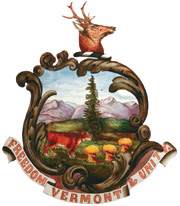
Coat of arms of Vermont
Encyclopedia

Vermont
Vermont is a state in the New England region of the northeastern United States of America. The state ranks 43rd in land area, , and 45th in total area. Its population according to the 2010 census, 630,337, is the second smallest in the country, larger only than Wyoming. It is the only New England...
. Most of the elements found in the coat of arms originate in the Great Seal of Vermont designed by Ira Allen
Ira Allen
Ira Allen was one of the founders of Vermont, and leaders of the Green Mountain Boys; and was the brother of Ethan Allen.-Biography:...
. Whereas the Great Seal of Vermont is reproduced in a single color and is reserved for embossing and authenticating state documents, the coat of arms is a more naturalistic and colorful representation of many of the same elements. The earliest representation of the coat of arms of Vermont is found on an engraved 1821 state military commission. The exact designer is not known, but it is likely that then Secretary of State Robert Temple worked with an engraver in developing the arms. Considerable liberties were taken in early depictions of the coat of arms. The location of the cow and the sheaves (bundles of cereal grains) moved about the foreground, and the height of the pine tree and size of the buck's head also varied. A state statute was approved in 1840, and modified in 1862, both attempts to codify and create more consistent representation of the arms. The coat of arms was cast in brass to ornament uniforms of Vermont's military regiments before, and through the U.S. Civil War, when individual states raised and trained their own regiments.
Today the coat of arms appears on the current flag of Vermont
Flag of Vermont
The flag of the state of Vermont consists of the state's coat of arms and motto. The Vermont General Assembly adopted the current flag on June 1, 1923....
, above the rostrum in the Hall of Representatives at the Vermont State House
Vermont State House
The Vermont State House, located in Montpelier, is the state capitol of Vermont and the seat of the Vermont General Assembly. The current Greek Revival structure is the third building on the same site to be used as the State House...
, on state court buildings, stationery, signage marking the Vermont border, and at Vermont Welcome Centers.
The blazon
Blazon
In heraldry and heraldic vexillology, a blazon is a formal description of a coat of arms, flag or similar emblem, from which the reader can reconstruct the appropriate image...
was formalized and described by state statute in 1840 in the following manner: "the coat of arms of the state shall be, and is described as follows: Green, a landscape occupying half of the shield; on the right and left, in the background, high mountains, blue; the sky yellow. From near the base, and reaching nearly to the top of the shield, arises a pine-tree of the natural color, and between three erect sheaves, yellow, placed bendwise on the dexter side, and a red cow standing on the sinister side of the field. The Crest: A buck's head, of the natural color, cut off and placed on a scroll, blue and yellow. The Motto and Badge: On a scroll beneath the shield, the motto: Vermont: Freedom and Unity. The Vermonter's Badge: two pine branches of natural color, crossed between the shield and scroll." The crest and Vermonter's Badge, can also be seen, in modified form, on the Vermont Military Crest
Vermont Military Crest
The Vermont Military Crest was first used in the coats of arms of units of Vermont state regiments, and later by the Vermont National Guard, as granted by the precursor organizations of what is now the United States Army Institute of Heraldry...
.
The "Vermonter's Badge" described in the statute was worn as an expression of Vermont identity by citizens during the period of the Vermont Republic
Vermont Republic
The term Vermont Republic has been used by later historians for the government of what became modern Vermont from 1777 to 1791. In July 1777 delegates from 28 towns met and declared independence from jurisdictions and land claims of British colonies in New Hampshire and New York. They also...
, and again during the American Civil War by Vermont's military regiments. The motto Freedom and Unity
Freedom and Unity
"Freedom and Unity" is the official motto of the U.S. state of Vermont. The motto was first adopted in 1788 for use on the Great Seal of the Vermont Republic. Ira Allen designed the Vermont seal and is often credited as its author...
is central to the Vermont ideal of balancing personal freedom with the individual's responsibility to their community.
Seals of the Government of Vermont
Many government seals of Vermont use the State's coat of arms.See also
- Coats of arms of the U.S. statesCoat of Arms of the U.S. StatesThe coats of arms of the U.S. states are coats of arms, adopted by those states that have chosen, that are an official symbol of the state, alongside their seal. Eighteen states have officially adopted coats of arms...
- Seal of VermontSeal of VermontThe Great Seal of the State of Vermont is the official seal of the U.S. state of Vermont, used to emboss and authenticate official documents. It was designed by Ira Allen, brother of Ethan Allen and one of the state's founders.-Great Seal:...

